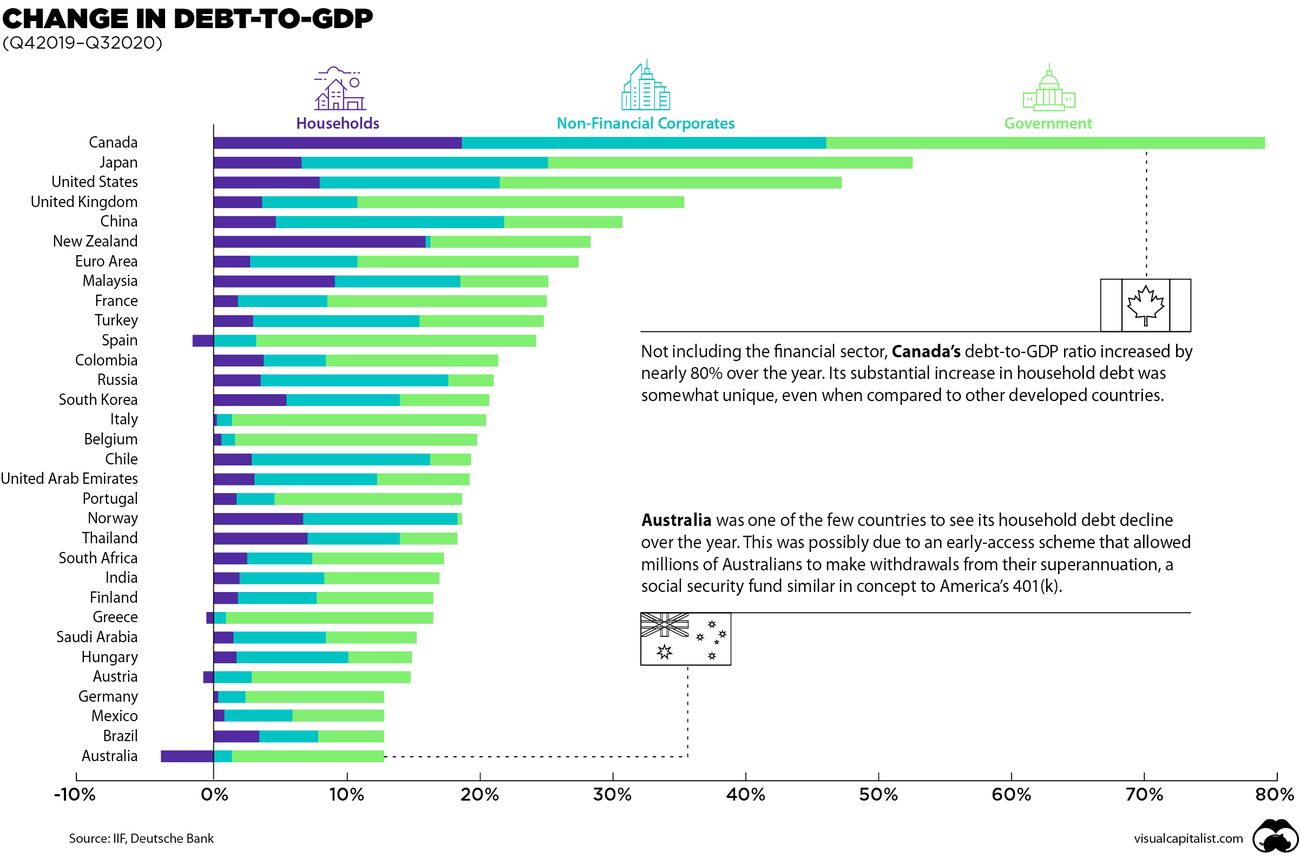Debt-to-GDP Ratio Explained: The Key Formula Behind Economic Health

The US debt-to-GDP ratio has almost doubled since early 2008 and now stands at 120.73% in Q3 2024. This significant economic indicator tells us much more than what appears on a spreadsheet.
Research shows that a country’s annual growth drops by 1.7% when its debt-to-GDP ratio goes beyond 77%. This is a big deal as it means that nations face most important economic hurdles above this threshold. Japan proves this metric isn’t straightforward – its ratio sits at 248.7% as of 2025, yet the country avoids immediate financial disasters.
- Debt-to-GDP Ratio Measures Fiscal Health: It compares a country’s total debt to its GDP, signaling how manageable its debt is relative to its economy.
- Critical Thresholds Exist: Ratios above 77% reduce annual growth by 1.7%; the threshold drops to 64% for emerging markets.
- Japan Is an Outlier: Despite a 248.7% ratio, Japan avoids crisis due to domestic bond ownership, low rates, and net asset positions.
- Economic Consequences Are Real: High ratios raise borrowing costs, suppress investment, slow wage growth, and weaken currencies.
- Interest Costs Escalate Quickly: Rising debt-to-GDP drives higher interest payments, cutting into government service budgets.
- Ratings and Credibility Are Affected: Rating agencies factor in debt levels, especially for mid-tier economies vulnerable to downgrades.
- Global Debt Is Surging: The U.S. ratio is projected to hit 170% by the mid-2050s—an urgent call for fiscal sustainability worldwide.
What Is the Debt-to-GDP Ratio and Why It Matters
The debt-to-GDP ratio stands as a key economic indicator that shows how a country’s government debt compares to its economic output. This metric reveals a government’s financial health and its ability to handle existing obligations without taking on more debt.
The simple definition of debt-to-GDP ratio
A country’s debt-to-GDP ratio compares what it owes to what it produces economically in a given period. This percentage gives us a standard way to review a nation’s debt burden. The math behind it follows a clear formula:
Debt-to-GDP Ratio = (Total Government Debt ÷ Gross Domestic Product) × 100
Note that this ratio means more than just a number—it shows how many years a country would need to pay off all debt if it used its entire GDP for debt repayment. To cite an instance, see a business that borrowed $10,000 and generated $50,000 in revenue—its “personal debt-to-GDP ratio” would be 20 percent.
How economists use this metric to assess economic health
The debt-to-GDP ratio helps economists review fiscal sustainability and economic stability. World Bank research suggests that countries with ratios above 77% for extended periods face economic slowdowns, and each percentage point above this threshold could reduce annual real growth by 1.7%.
Notwithstanding that, different economies interpret this differently. Japan managed to keep a ratio above 200% for over a decade without defaulting. This shows why economists think about multiple factors beyond raw numbers.
OECD statistics point out that people and institutions using debt-to-GDP ratios should know the difference in what these figures mean. The ratio might refer to general government debt (central, state, local governments plus social security funds) or broader public sector debt (including public corporations).
Why investors and policymakers track this number
This ratio signals potential risks and opportunities to investors and policymakers. A country’s rising debt-to-GDP ratio often means creditors just need higher interest rates, which raises borrowing costs. On top of that, governments with high ratios usually have less room to maneuver during economic downturns.
The Congressional Budget Office projects that current policies will push the U.S. debt-to-GDP ratio to approximately 100% in 2025 and possibly to 170% by the mid-2050s. These numbers raise concerns about “crowding out” private investment as public debt drives interest rates up.
Too much debt can hurt economic growth in several ways. Resources might shift away from productive investment, lead to inflation pressures, and even destabilize the currency. The debt-to-GDP ratio remains one of the most important metrics to assess a country’s long-term economic future.
How to Calculate Debt-to-GDP Ratio: The Formula Explained

Image Source: Visual Capitalist
The debt-to-GDP ratio uses a simple formula that shows how a nation’s economy stands. You only need two main values to calculate this ratio, unlike other complex economic metrics.
Breaking down the debt-to-GDP ratio formula
The debt-to-GDP ratio formula is simple:
Debt-to-GDP Ratio = (Total Debt ÷ Gross Domestic Product) × 100
This equation shows the link between a country’s total sovereign debt and its GDP in a specific period. The percentage tells us how many years a country would need to pay off all debt if it used its entire economic output.
The ratio actually represents a unit of time, not just a dimensionless quantity. Economists study this ratio through multiple periods to spot worrying trends.
Step-by-step calculation example
Here’s how the calculation works:
- Gather the necessary data: Total debt and GDP figures for the same period
- Divide the total debt by the GDP
- Multiply the result by 100 to express as a percentage
Let’s look at a sample country with:
- Total debt: $11,788 billion
- GDP: $5,000 billion
Debt-to-GDP ratio = ($11,788 billion ÷ $5,000 billion) × 100 = 235.76%
Germany’s numbers show this in action. Their 2020 debt reached $2,622 billion with a GDP of $3,806 billion, resulting in a debt-to-GDP ratio of 68.9%.
Tools and resources for tracking current ratios
You can find current debt-to-GDP data from these trusted sources:
- International Monetary Fund (IMF) DataMapper: Offers complete global data with visualization tools
- World Bank Database: Shows historical debt-to-GDP information for most countries
- Trading Economics: Displays current ratios with forecasts and historical trends
- OECD Statistics: Gives detailed data for member countries
These platforms update their data yearly or quarterly. They help track economic trends across nations.
What Is a Good Debt-to-GDP Ratio? Benchmarks and Thresholds
A country’s economic circumstances play a major role in what makes a “good” debt-to-GDP ratio. Research has identified several key measures, though no single threshold works for all economies.
The 77% threshold identified by economic research
World Bank research shows 77% as a critical debt-to-GDP threshold for most economies. Growth takes a hit when debt goes beyond this level – each extra percentage point cuts annual real growth by about 0.017 percentage points. The impact hits emerging markets even harder, where the threshold drops to 64% and each point above costs roughly 0.02 percentage points in annual real growth.
Yes, it is worth noting that other studies point to different measures. Harvard economists Reinhart and Rogoff suggest 90% as a useful threshold. The European Union’s Stability and Growth Pact (SGP) wants member countries to keep government debt under 60% of GDP.
How different economies handle varying ratio levels
Debt tolerance varies between developed and developing economies. Developing and emerging economies should keep their debt-to-GDP ratio below 40% in the long run. The IMF points out that no single threshold can describe the difference between ‘bad’ and ‘good’ debt ratios.
Of course, some countries carry higher ratios without immediate problems. The International Monetary Fund’s research shows estimated debt limits from 150% to 260% of GDP, with most countries around 192%. A country’s ability to handle higher debt depends on several factors:
- Room to raise taxes compared to other countries
- Strong economic growth that brings in tax revenue
- Knowing how to issue debt in local currency
- A stable political climate and military security
Case study: Japan’s high ratio but low default risk
Japan stands out with the world’s highest debt-to-GDP ratio – expected to hit 248.7% by 2025. The country has kept debt above 100% for more than twenty years without facing a debt crisis.
Japan stays stable thanks to several unique factors. The Bank of Japan holds about half of all government debt, which equals roughly 100% of GDP. Japanese investors own most of the country’s debt, while foreign investors hold just 8%. The government also owns substantial assets that bring down its net debt position to 172% of GDP.
The Japanese approach involves borrowing at very low interest rates and putting money into higher-return, riskier assets. This strategy works well because of strong local demand for government bonds, helping Japan maintain fiscal stability despite its massive debt ratio.
Real-World Impact: How Debt-to-GDP Affects Countries
A country’s debt-to-GDP ratio means more than just numbers on paper – it shapes people’s everyday lives in several ways.
Economic growth implications
The national debt load affects economic growth directly. Studies show that growth starts to suffer when debt hits 77% of GDP. Each point above this mark cuts annual real growth by 0.017 percentage points. The situation is even worse for emerging markets. Their tipping point sits at 64%, and each extra point costs them 0.02 percentage points in growth.
This slowdown happens because government borrowing eats up resources that businesses could use to invest. The Congressional Budget Office tells us that private investment drops by 33 cents for every dollar added to the federal deficit. Less investment means workers can’t be as productive, and wages don’t grow as much.
Interest rates and borrowing costs
Heavy debt loads push interest rates up. Research from the American Enterprise Institute shows that each percentage point rise in the debt-to-GDP ratio drives 10-year Treasury yields up by 4.5 basis points. This is almost twice what the Congressional Budget Office expected.
Higher rates make borrowing more expensive for the government. The average interest rate on U.S. national debt has doubled from 1.7% to 3.4% recently. This pushed interest costs from $352 billion to $881 billion. Money spent on interest payments can’t go to other important government services.
Currency valuation effects
Too much debt can hurt a country’s currency value. Countries carrying heavy debt loads see their currencies perform worse than those with better fiscal health. Looking at recent data, the link between total debt-to-GDP ratios and currency futures returns showed a -0.75 correlation over five years.
Countries with big debt burdens risk seeing their currency lose value as markets realize debts might be paid back with “currencies that are progressively worth less and less”.
Credit rating consequences
Rating agencies watch debt-to-GDP ratios carefully when they grade countries. More debt usually means lower credit ratings. We saw this play out when Fitch lowered the U.S. credit rating in 2023, pointing to debt concerns.
The effect of debt on ratings varies. It barely matters for countries with very low ratings, matters somewhat for top-rated ones, and hits hardest for those in the middle – like strong emerging markets and weaker advanced economies.
Conclusion
Debt-to-GDP ratios tell us a lot about a nation’s economic health. This metric might look complicated at first glance but it’s a great way to get clear picture of a country’s financial stability and growth potential.
Studies show that economic growth slows down by a lot when these ratios cross certain levels—77% for developed nations and 64% for emerging markets. Japan’s case proves interesting because it shows how some countries can handle higher ratios without facing immediate problems.
These numbers affect more than just government spreadsheets. They influence your daily life through changes in interest rates, currency values, and economic growth. Each country needs different debt levels based on its unique situation, but keeping debt manageable is vital for stable long-term economic growth.
Global debt keeps climbing higher every year. Investors, policymakers, and citizens need to watch these debt-to-GDP ratios carefully. This number works like an early warning system that helps spot economic troubles before they turn into full-blown crises.
